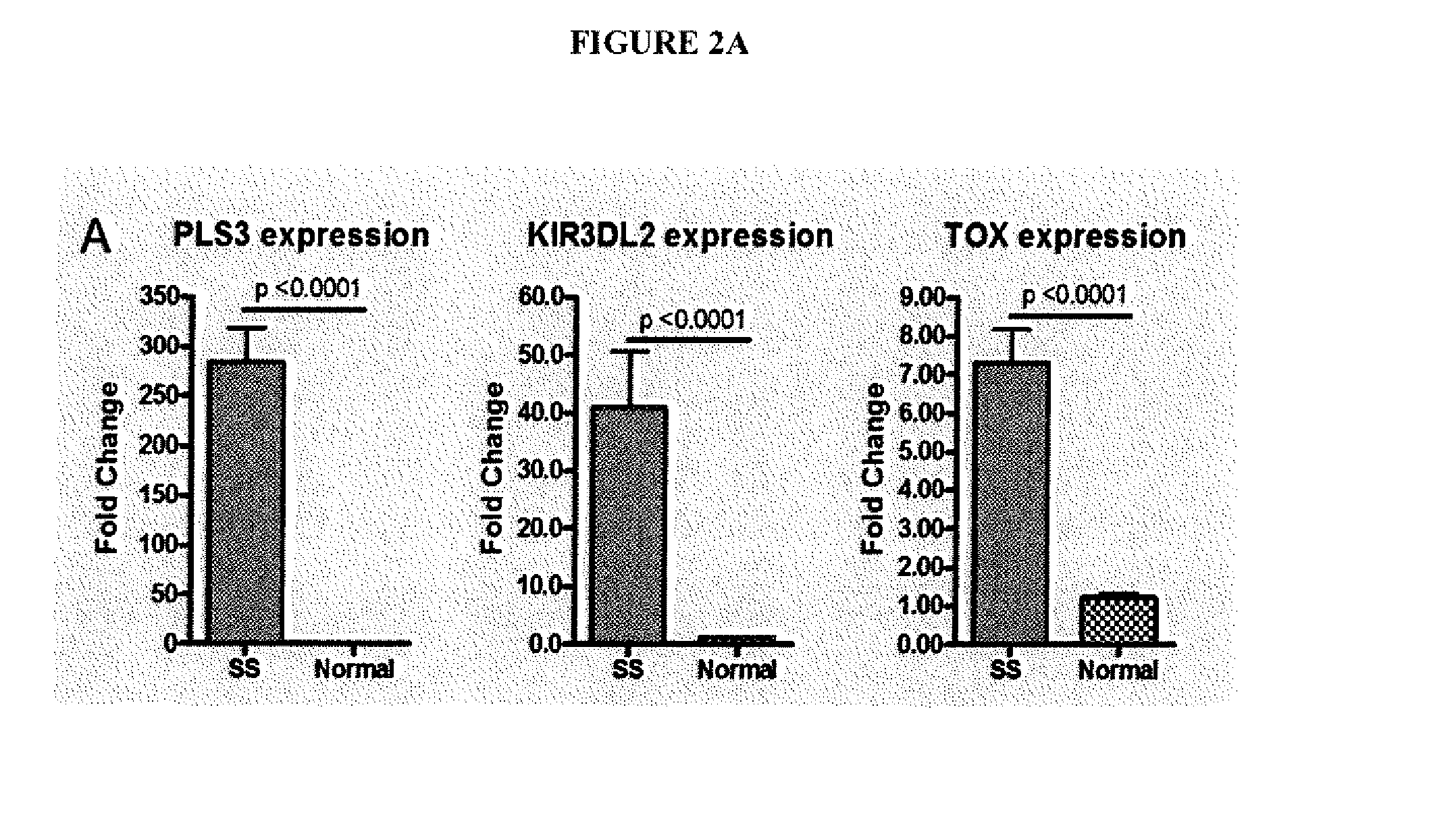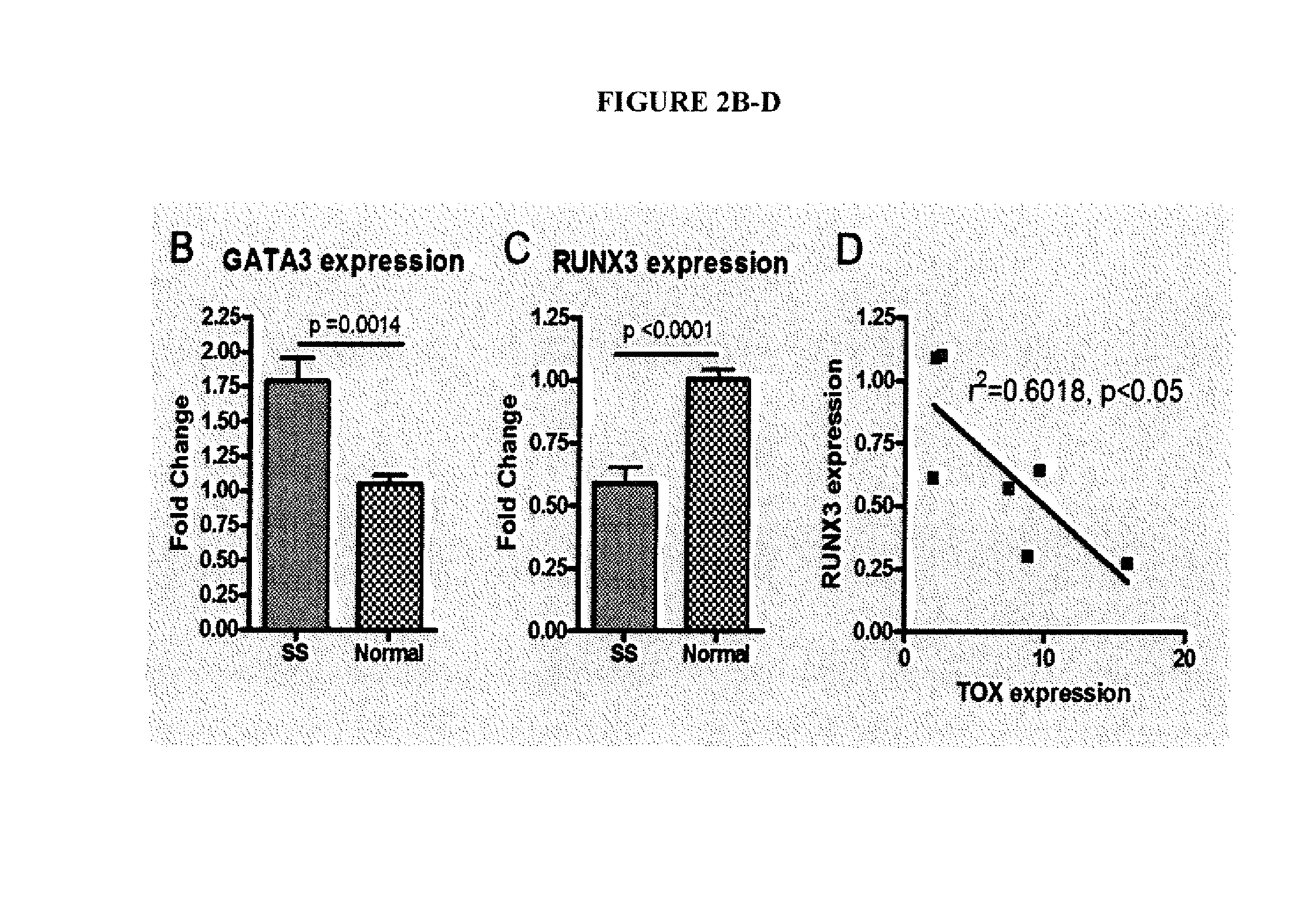Method for diagnosis, prognosis and determination of treatment for cutaneous t-cell lymphoma
- Summary
- Abstract
- Description
- Claims
- Application Information
AI Technical Summary
Benefits of technology
Problems solved by technology
Method used
Image
Examples
example 1
6. EXAMPLE 1
Components of the TOX-RUNX3 Pathway Are Differentially Expressed in Cutaneous T-Cell Lymphoma
[0030]A sequence-based transcriptome approach that focuses on malignant cells in Sézary Syndrome (SS) and mycosis fungoides (MF) was used to identify genes that are dysregulated in CTCL and which may serve as biomarkers or targets for treatment. Five genes were selected for further study, namely T-plastin (PLS3), Thymocyte selection-associated high mobility group box protein (TOX), Killer cell immunoglobulin-like receptor 3DL2 (KIR3DL2), Integrin β1 (ITGB1) and Programmed cell death 6 (PDCD6) (FIG. 1).
[0031]Quantitative real-time polymerase chain reaction (qRT-PCR) was used to measure expression of genes in CD4+ T cells from SS patients versus normal controls. Table 1 shows the profiles of the SS patients studied.
TABLE 1Age / Sex / PatientRaceDiagnosis, StageCurrent Tx158 WMT3N1M0B2 / Stage IVA1, SSRomidepsin280 WFT3N0M0B2 / Stage IVA1, SSPhotophoresis,Targretin342 AAFT3N1M0B2 / Stage IVA1...
example 2
7. EXAMPLE 2
[0035]Isolated PBMCs were cultured overnight and the next day divided into two treatment groups: 4 μM romidepsin and 20 uM pralatrexate. Each treatment was added 24 hours following culture initiation and was replaced along with fresh media 24 hours after initial treatment. After 48 hours of incubation with treatment, RNA was isolated from treated cells using RNAprotect and RNeasy (Qiagen, Valencia, Calif.) per manufacturer's instructions. For cDNA synthesis, total RNA (100 ng) was used for Reverse Transcription (RT) with Superscript II reverse transcriptase (Life Technologies, Gaithersburg, Md.) using oligo dT primers according to the recommendations of the manufacturer. 2 ul of the resulting cDNA was used for each PCR reaction. Quantitative reverse transcription PCR was performed using TaqMan PCR master mix (Applied Biosystems, Foster City, Calif.) together with TaqMan probes and primers (Applied Biosystems) using standard conditions. Expression of TOX, PLS3 and RNX3 ge...
example 3
8. EXAMPLE 3
[0037]5 ng of TOX Silencer Select Validated siRNA (Ambion, Carlsbad, Calif.) was added along with 1.5 μL of TransIT-siQUEST Transfection Reagent (Mirus, Madison, Wis.) per manufacturer's instruction to cultured PBMCs from patients 24 hours after culture was initiated. 72 hours later, RNA was isolated from treated cells using RNAprotect and RNeasy (Qiagen, Valencia, Calif.) per manufacturer's instructions. For cDNA synthesis, total RNA (100 ng) was used for Reverse Transcription (RT) with Superscript II reverse transcriptase (Life Technologies, Gaithersburg, Md.) using oligo dT primers according to the recommendations of the manufacturer. 2 μl of the resulting cDNA was used for each PCR reaction. Quantitative reverse transcription PCR was performed using TaqMan PCR master mix (Applied Biosystems, Foster City, Calif.) together with TaqMan probes and primers (Applied Biosystems) using standard conditions.
[0038]As shown in FIG. 6, siRNA knockdown of TOX resulted in decreased...
PUM
| Property | Measurement | Unit |
|---|---|---|
| Therapeutic | aaaaa | aaaaa |
Abstract
Description
Claims
Application Information
 Login to View More
Login to View More - R&D
- Intellectual Property
- Life Sciences
- Materials
- Tech Scout
- Unparalleled Data Quality
- Higher Quality Content
- 60% Fewer Hallucinations
Browse by: Latest US Patents, China's latest patents, Technical Efficacy Thesaurus, Application Domain, Technology Topic, Popular Technical Reports.
© 2025 PatSnap. All rights reserved.Legal|Privacy policy|Modern Slavery Act Transparency Statement|Sitemap|About US| Contact US: help@patsnap.com



